The French Fries Cutter Market is estimated to be valued at USD 4.2 billion in 2025 and is projected to reach USD 7.7 billion by 2035, registering a compound annual growth rate (CAGR) of 6.3% over the forecast period.
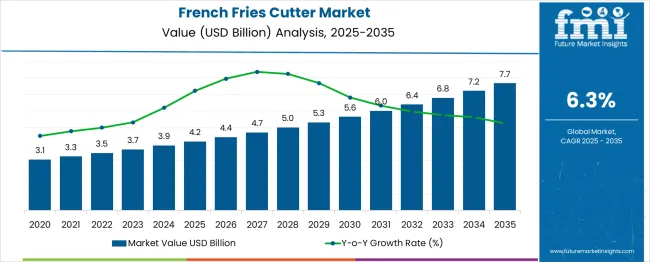
The French Fries Cutter market is progressing steadily as the foodservice industry and household demand for convenience-oriented kitchen tools expand. Rising consumer preference for homemade and freshly cut fries, coupled with growing professional kitchens in quick service restaurants and cloud kitchens, is enhancing adoption of efficient cutting tools.
Industry dynamics reflect a shift toward durable and hygienic equipment capable of delivering consistent results, meeting both aesthetic and food safety standards. Future growth is expected to be supported by innovations in blade technology, ergonomic designs, and enhanced safety features, which are making cutters more attractive to both commercial and home users.
Increasing awareness about minimizing food wastage and improving operational speed in food preparation is also paving the way for new opportunities and further market penetration across diverse end-user segments.
The market is segmented by Product Type, Operating Mode, Blade Material, Material, End-use, Distribution Channel, and Application and region. By Product Type, the market is divided into Heavy Duty and Standard Duty. In terms of Operating Mode, the market is classified into Manual, Semi-Automated, and Fully-Automated. Based on Blade Material, the market is segmented into Stainless Steel, Mild Steel, and Plastic.
By Material, the market is divided into Cast Iron and Plastic. By End-use, the market is segmented into Hotel and Restaurants, Bakery, Household, Cafes, Domestic Purpose, and Cloud Kitchens. By Distribution Channel, the market is segmented into Online, Hypersmart, Super Mart, Retailer, and Distributors.
By Application, the market is segmented into Restaurants, Hotel, Cafes, Domestic Purpose, and Cloud Kitchens. Regionally, the market is classified into North America, Latin America, Western Europe, Eastern Europe, Balkan & Baltic Countries, Russia & Belarus, Central Asia, East Asia, South Asia & Pacific, and the Middle East & Africa.
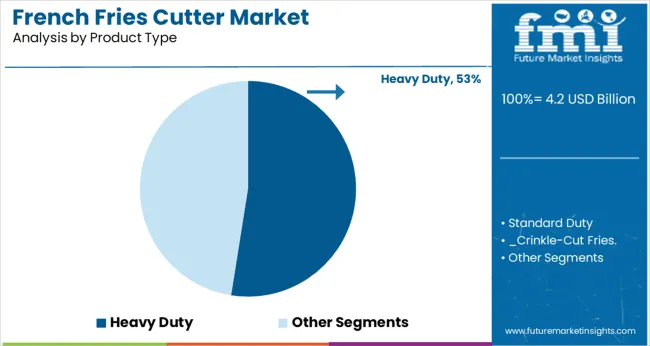
When segmented by product type, heavy duty French fries cutters are expected to account for 52.5% of the total market revenue in 2025, making it the leading product type segment. This dominance has been driven by the durability and robustness of heavy duty cutters, which have enabled them to withstand high volume usage in commercial kitchens.
Their sturdy construction and ability to handle large quantities of potatoes with minimal user effort have made them indispensable in environments where efficiency and consistency are prioritized. The segment’s leadership has also been reinforced by demand for equipment that offers longevity, reduces maintenance frequency, and meets the rigorous standards of professional kitchens.
Enhanced cutting precision and compatibility with interchangeable blades have further contributed to its strong position among both commercial and discerning household consumers seeking long-term value.
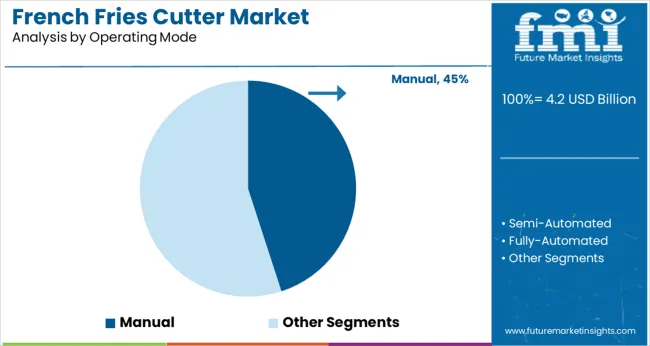
In terms of operating mode, manual cutters are projected to hold 45.0% of the market revenue in 2025, maintaining their prominence within the segment.
This position has been secured by their simplicity, affordability, and reliability, which have made them a preferred choice for both small food businesses and households. Manual cutters require no electricity, offering flexibility in diverse environments and ensuring ease of use without technical expertise. Their portability and minimal maintenance requirements have further supported adoption, especially in settings where operational costs and space constraints are significant considerations.
The segment’s growth has also been sustained by their suitability for moderate volumes and by consumer confidence in their straightforward operation, which aligns with the increasing emphasis on cost-effectiveness and practicality.
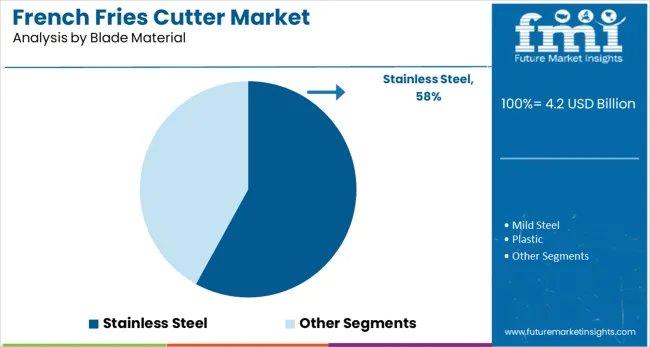
When segmented by blade material, stainless steel blades are forecast to capture 58.0% of the market revenue in 2025, establishing themselves as the most dominant material choice. This leadership has been underpinned by the superior durability, corrosion resistance, and hygiene offered by stainless steel, attributes that are particularly valued in food preparation environments.
The material’s ability to retain sharpness over time while withstanding frequent washing and sanitization has made it the preferred option among professionals and home users alike. Additionally, stainless steel blades contribute to precise and uniform cuts, enhancing presentation and reducing wastage, which have become key purchase drivers.
The combination of food safety compliance, low maintenance, and long-term reliability has reinforced stainless steel’s preeminence as the blade material of choice in the French fries cutter market.
A French fry cutter is a kitchen appliance that helps to cut potatoes into the thin strips that are used to make French fries. The French Fry Cutter is a kitchen appliance that helps to cut potatoes into the thin strips that are used to make French fries. There are several drivers for this product in the French fries cutters market, including:
It is critical to segment according to operating type when choosing the best French fries cutter for your company. The three types in the French fries cutters market are manual, electric, and automatic.
The most fundamental category of the French fries cutters market is the manual cutter. It is hand-operated and it does not require electricity. Manual cutters have become less expensive than electric or automatic cutters but less efficient.
The manual cutter is less expensive than the electric cutter, but it is also less efficient. Electric cutters are more convenient and faster to use than manual cutters, and they produce more consistent results. The automatic cutter is the most expensive, but it is also the most efficient type of French fries cutter boosting the French fries cutters market adoption trends.
French fry cutters are one of those applications that have a very diverse range of end users. They can be found in hotel cafes, household kitchens, and even some restaurants. One thing that is certain, however, is that French fry cutters are most commonly used in commercial settings. This, in turn, escalates the French fries cutters market trends.
This is likely due to the fact that they can save a lot of time and labor when it comes to cutting potatoes into fries. In addition, they often come with a number of different size options, which makes them ideal for catering to large groups. These factors ramp up the adoption of French fries cutters as well as the demand for French fries cutters.
The French fries cutter market is anticipated to grow at 6.3% CAGR, a steady pace during the forecast period 2025 to 2035, estimated by FMI. The French fries cutters market is growing at a rapid pace, propelled by the demand from both supermarkets and industrial distributors.
The major factors driving the French fries cutters market growth are increasing demand from consumers and businesses for convenience foods and rising disposable incomes. However, health concerns regarding the consumption of fried foods are expected to restrain French fries cutters' market growth during the forecast period.
Supermarkets are the largest end-users of the French fries cutters market, accounting for over 50% of the total demand. The increasing popularity of frozen French fries among consumers is driving the demand for French fries cutters in supermarkets.
Businesses such as restaurants, hotels, and canteens are also major end-users of French fries cutters. The growing demand for ready-to-eat food items in these businesses is fueling the French fries cutters market growth. Industrial distributors are another key driver of French fries cutters market growth. These distributors supply French fries cutters to various end-users such as supermarkets, restaurants, and hotels.
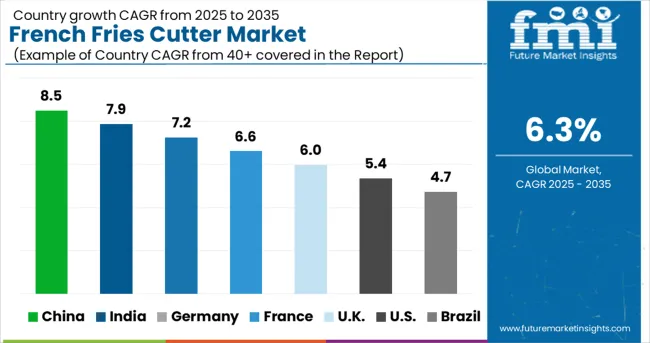
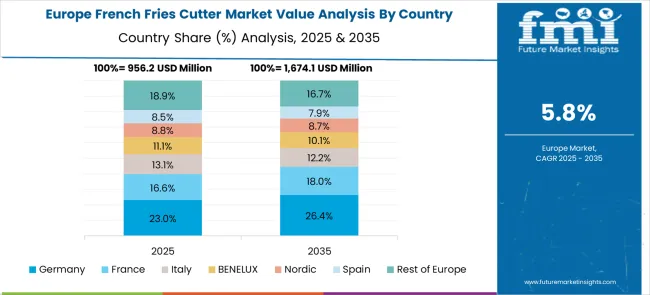
In Europe, the French fries cutter market accounts for 40% of the total market share, estimated to be worth USD 4.2 million in 2025. In Europe, they are often eaten as a snack or starter and sometimes even as a main course. There is even a national holiday dedicated to French fries in Belgium. This, in turn, escalates the French fries cutter market trends.
The United Kingdom French fries cutter growth is projected to account for 22% of the market in 2025, with a share value of USD 175.8 million. The humble French fry has been a staple of the American diet for decades now. In America, French fries are often served as a side dish to burgers and sandwiches. They can also be found in many fast-food restaurants.
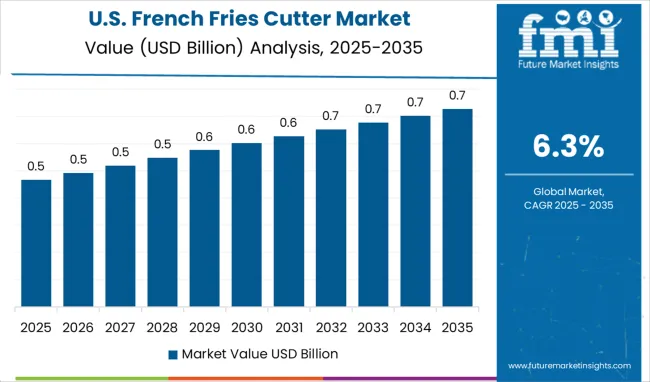
United States’ French Fries Cutter Market
The USA-French fries cutter market is estimated to account for 68% of the market, with a share value of USD 516.3 million. United States’ French fries cutter market The USA-French fries cutter market is expected to grow at a French fries cutter market share of 38% during the forecast period of 2025 to 2035.
The major drivers for the French fries cutter market are the increasing demand for processed and convenience food and the growing popularity of French fries as a fast-food item. The high demand for French fries in the United States is resulting in an increased demand for French fries cutters.
Canadian French Fries Cutter Market
Processed food has been gaining popularity in recent years owing to the hectic lifestyles of consumers. Convenience foods are in high demand as they save time and effort. French fries are a popular convenience food and are consumed extensively in Canada. This has resulted in an increased demand for French fries cutters in Canada.
The Asia Pacific market for French fries cutters is growing rapidly due to the high demand from emerging economies. The key factors which are provoking this growth are increasing disposable incomes, urbanization, and the growing preference for Western-style food.
China French Fries Cutter Market
The Chinese French fries cutter market growth is projected to account for 32% of the market by 2025, with a share worth USD 115.1 million. Due to the high demand for French fries cutters from these countries, manufacturers are racing to keep up with the demand by investing in new production facilities and expanding their existing ones.
This is resulting in a rapid increase in the supply of French fries cutters, which is driving down prices and making them more affordable for consumers. This presents a huge French fries cutter market opportunity for manufacturers to capitalize on this growing French fries cutter market and reap huge profits.
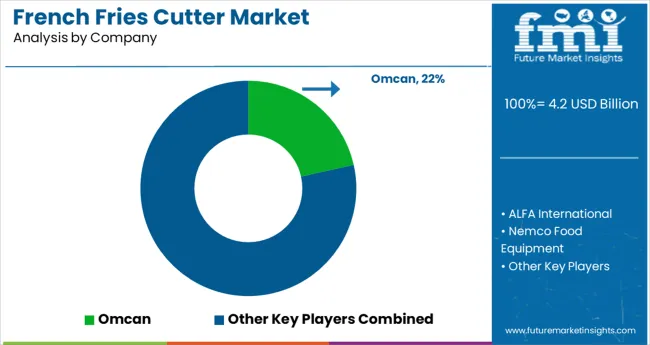
The competitive landscape of the French fries cutters market is quite diverse, with a large number of consumer and business-oriented companies vying for French fries cutters market share.
The overall demand for French fry cutters has been growing steadily in recent years due in part to the popularity of fast-food restaurants and the increased consumption of French Fries.
A number of well-established companies compete in the French fry cutter market, including Cuisinart, Hamilton Beach, and Black & Decker. These companies have a wide variety of products to choose from, ranging from simple hand-held devices to more complex countertop models.
In addition to the major players in the French fries cutters market, there are also a number of smaller companies that offer more specialized products. For example, some companies focus on producing higher-quality cutters for use in restaurants, while others offer more affordable options for home use.
The growing demand for processed and convenience foods is the major factor driving the French fries cutters market growth. The increasing disposable income and changing lifestyle of consumers are also some of the key factors propelling the demand for French fries cutters.
However, the high cost of these cutters may restrain the French fries cutters market growth to some extent. Moreover, the easy availability of alternatives such as manually operated potato slicers is also anticipated to challenge the French fries cutters market growth during the forecast period.
| Attribute | Details |
|---|---|
| Forecast Period | 2025 to 2035 |
| Historical Data Available for | 2020 to 2025 |
| Market Analysis | million for Value and Units for Volume |
| Key Regions Covered |
North America; Latin America; Europe; Asia Pacific; Oceania; Middle East and Africa (MEA) |
| Key Countries Covered |
The USA, Canada, Mexico, Germany, United Kingdom, France, Italy, Spain, China, Japan, India, South Korea, Australia, Brazil, Argentina, South Africa, UAE |
| Key Segments Covered |
By Product, By Type, By Material, By Blade Material, By Operating mode, By End-user, By Distribution Channel, By Region |
| Key Companies Profiled |
Omcan; ALFA International; Nemco Food Equipment; The Vollrath Company; Norpro; Thunder Group; Browne Food Service; Robot Coupe; Traditional catering products; Uniworld Food Service Equipment; Crown Marks; Matfer Bourgeat United States; TigerChef; Edlund Company |
| Report Coverage | Market Forecast, Company Share Analysis, Competitive Landscape, DROT Analysis, Market Dynamics and Challenges, and Strategic Growth Initiatives |
| Customization & Pricing | Available upon Request |
The global french fries cutter market is estimated to be valued at USD 4.2 billion in 2025.
It is projected to reach USD 7.7 billion by 2035.
The market is expected to grow at a 6.3% CAGR between 2025 and 2035.
The key product types are heavy duty, standard duty, _crinkle-cut fries., _curly fries., _home fries., _shoestring fries., _steak fries., _sweet potato fries., _tater tots. and _tornado fries..
manual segment is expected to dominate with a 45.0% industry share in 2025.






Our Research Products

The "Full Research Suite" delivers actionable market intel, deep dives on markets or technologies, so clients act faster, cut risk, and unlock growth.

The Leaderboard benchmarks and ranks top vendors, classifying them as Established Leaders, Leading Challengers, or Disruptors & Challengers.

Locates where complements amplify value and substitutes erode it, forecasting net impact by horizon

We deliver granular, decision-grade intel: market sizing, 5-year forecasts, pricing, adoption, usage, revenue, and operational KPIs—plus competitor tracking, regulation, and value chains—across 60 countries broadly.

Spot the shifts before they hit your P&L. We track inflection points, adoption curves, pricing moves, and ecosystem plays to show where demand is heading, why it is changing, and what to do next across high-growth markets and disruptive tech

Real-time reads of user behavior. We track shifting priorities, perceptions of today’s and next-gen services, and provider experience, then pace how fast tech moves from trial to adoption, blending buyer, consumer, and channel inputs with social signals (#WhySwitch, #UX).

Partner with our analyst team to build a custom report designed around your business priorities. From analysing market trends to assessing competitors or crafting bespoke datasets, we tailor insights to your needs.
Supplier Intelligence
Discovery & Profiling
Capacity & Footprint
Performance & Risk
Compliance & Governance
Commercial Readiness
Who Supplies Whom
Scorecards & Shortlists
Playbooks & Docs
Category Intelligence
Definition & Scope
Demand & Use Cases
Cost Drivers
Market Structure
Supply Chain Map
Trade & Policy
Operating Norms
Deliverables
Buyer Intelligence
Account Basics
Spend & Scope
Procurement Model
Vendor Requirements
Terms & Policies
Entry Strategy
Pain Points & Triggers
Outputs
Pricing Analysis
Benchmarks
Trends
Should-Cost
Indexation
Landed Cost
Commercial Terms
Deliverables
Brand Analysis
Positioning & Value Prop
Share & Presence
Customer Evidence
Go-to-Market
Digital & Reputation
Compliance & Trust
KPIs & Gaps
Outputs
Full Research Suite comprises of:
Market outlook & trends analysis
Interviews & case studies
Strategic recommendations
Vendor profiles & capabilities analysis
5-year forecasts
8 regions and 60+ country-level data splits
Market segment data splits
12 months of continuous data updates
DELIVERED AS:
PDF EXCEL ONLINE
French Patio Door Market Size and Share Forecast Outlook 2025 to 2035
French Square Bottle Market Size and Share Forecast Outlook 2025 to 2035
French Doors Market Size and Share Forecast Outlook 2025 to 2035
Cutter Box Films Market Growth – Demand & Trends Forecast 2025-2035
Cutter-Box Packaging Market
Die-Cutter Market
Coal Cutter Pick for Mining Market Size and Share Forecast Outlook 2025 to 2035
Tile Cutter Market
Pizza Cutter Market Size and Share Forecast Outlook 2025 to 2035
Fixed Cutter Bits Market
Hybrid Cutters Market Analysis Size and Share Forecast Outlook 2025 to 2035
Flatbed Die Cutters Market Size and Share Forecast Outlook 2025 to 2035
Soluble-Film Cutters Market Analysis - Size and Share Forecast Outlook 2025 to 2035
Rotary Knife Cutters Market
Automatic Paper Cutter Market Size, Trends, and Forecast 2025 to 2035
Industrial Paper Cutter Market Segmentation based on Product Type, Application, Automation, End Use and Region: Forecast for 2025 and 2035
Indexable Milling Cutters Market Size and Share Forecast Outlook 2025 to 2035
Ultrasonic Surgical Cutters Market
CNC Industrial Paper Cutter Market Size and Share Forecast Outlook 2025 to 2035

Thank you!
You will receive an email from our Business Development Manager. Please be sure to check your SPAM/JUNK folder too.
Chat With
MaRIA